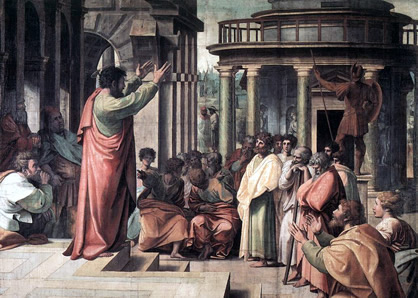Iconium (Konya) Acts 13:51;14:1-21;16:2, II Tim. 3:11
In the central plateau of the Lycaonian District, Iconium was a
city set amidst a very large fertile plain that stretched to the
north and east. Well watered and surrounded by an unusually
productive and stoneless alluvial soil, the farms of the region are
still some of modern Turkeys finest
![]() for
grains, orchards of plums and apricots.
for
grains, orchards of plums and apricots.
Ramsey noted that the historian Strabo was struck by the difference
between the barren fields of the Lycaonian plains, and the lush area
around Iconium. He concluded that the intelligent use of irrigation
probably made the difference, since they were both subject to
similar weather patterns.
The actual founding of the city is uncertain, but it is clear that
the city was proud of its Greek heritage. By 25 BCE, Iconium was
brought under the Roman province of Galatia. Holding on to their
Greek heritage, Dr. Luke assigns the name Hellenes to this people in
his writing.![]()
The city was connected by a roadway to Pisidian Antioch some eighty
miles to the northwest and had good lines of trade and
communication. It was a Greek minded community with a significant
but not dominant Jewish community. As a more democratic and Greek
metropolis, resistance against St. Paul and St. Barnabas was not
swift and decisive as in places with dominant leadership structures.
In this city some of this community stirred up mobs against St.
Pauls message, but St. Paul was evidently able to manage the unrest
for a period. The team remained in place, and saw considerable
success in their preaching. After a spell of success, another mob
began to stir. Unlike![]() Pisidian Antioch, where the aristocrats expelled St. Paul and his
companion, the mob of the Hellenes was stirred and eventually
threatened to stone them. St. Barnabas and St. Paul fled the city
south to Lystra and Derbe.
Pisidian Antioch, where the aristocrats expelled St. Paul and his
companion, the mob of the Hellenes was stirred and eventually
threatened to stone them. St. Barnabas and St. Paul fled the city
south to Lystra and Derbe.
In addition to St. Pauls first visit to Iconium, he returned on the
second journey and possibly on the third journey (Acts 16:1-4;
18:23). Certain of the Jewish community followed St. Paul from
Iconium and harassed him again in Lystra, pushing the crowd to stone
him (Acts 14:19). St. Paul recalls the problems he had in Galatia in
his late writings (2 Tim. 3![]() :11).
:11).
St. Pauls concerns over the perversion to the Gospel message were
directed at this and the surrounding communities in the Epistle to
the Galatians. In addition, Peters first Epistle was likely written
to this city, along with Lystra, Derbe and Pisidian Antioch (1 Pet.
1:1).
Biblical Sites in Turkey List


